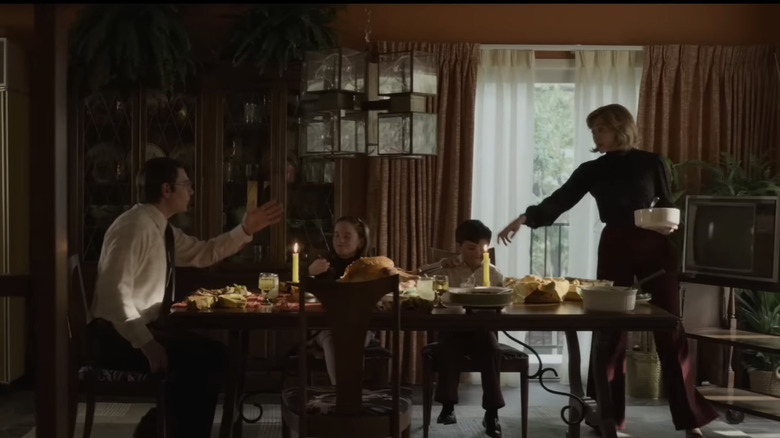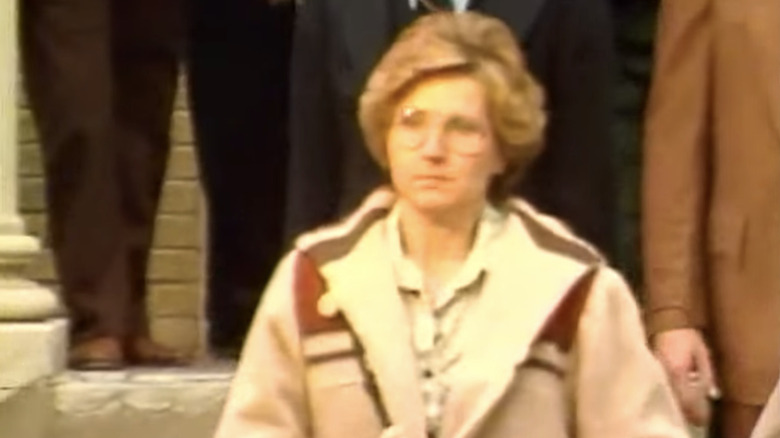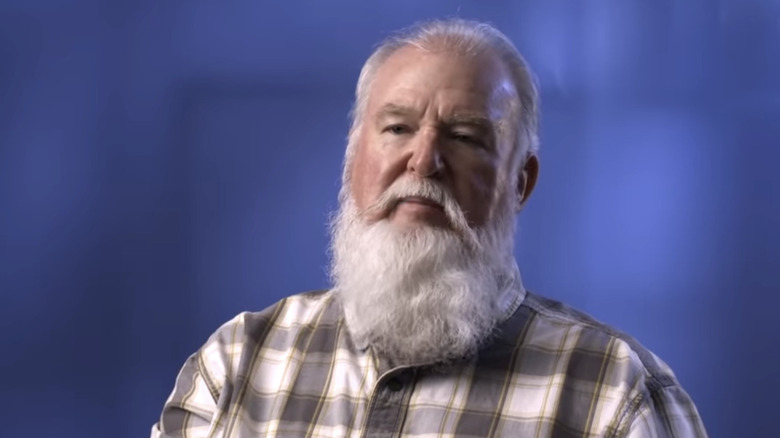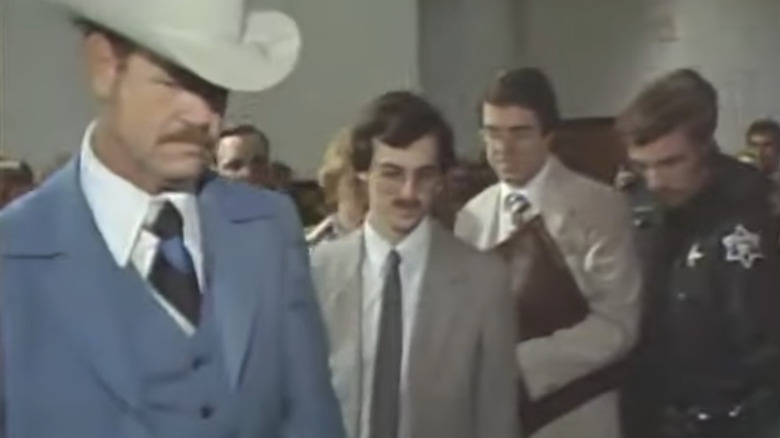Candy Montgomery: 12 Details About The Ax-Murdering Mom
History has no shortage of ax murderers. Many of them remain shrouded in mystery, like the culprits behind the Villisca ax murders, the jazz-loving killer known as the Axeman of New Orleans, and the disturbing Hinterkaifeck murders in rural Germany where the killer used a pickaxe-like tool to slay an entire family.
While culprit profiles have been drawn up over the years for these heinous crimes, they almost all point toward some traveling vagrant who migrates from town to town and manages to avoid capture. So, the last type of person most would think of as a possible ax murderer is a suburban housewife living in the Dallas-Fort Worth area, but that was the case for Candy Montgomery (via The Dallas Morning News). In 1980, her alleged crimes shocked the community and led to the unraveling of a story involving an affair, a self-defense plea, and, of course, an ax.
Married life with Pat Montgomery was fine until Fairview
Decades before the infamous and brutal murder that made headlines across the nation, Candace Wheeler was an "Army brat"whose father, a radar technician, had been stationed at a number of different military bases, forcing her to move frequently as she was growing up (via Texas Monthly). By the early 1970s, she was working as a secretary and met her future husband, an electrical engineer for Texas Instruments named Pat Montgomery.
For the first few years of their marriage, there were little to no signs of the issues that would arise later. The newlyweds had two children in quick succession; first, the couple had a daughter, Jenny, in 1973, followed by their son, Ian, in 1974. It was not until the family left a more urban environment and bought a home in the small town of Fairview, Texas, in 1977 that the monotony of domestic life caused cracks to form in Candy's relationship with Pat.
Candy Montgomery wanted to shake up her life
Those who moved to the Texas countryside in the 1970s did so because they were trying to stay away from the ever-expanding city of Dallas 20 miles away, which they viewed as busy, crowded, and crime-riddled, according to Texas Monthly. One of the main gathering places in the area was a small church, the Methodist Church of Lucas. It was there that Betty Gore and Candy Montgomery first met.
The two were heavily involved in the church and became inextricably linked in the years to come. Montgomery confided in close friends that she wanted to have an affair. She was married, but she felt as though her life had grown stale. Eventually, Montgomery engaged in an extramarital affair with Gore's husband, Allan, to shake up what she saw as her boring life. The affair ended a year before Gore's mangled body was discovered in a utility room in her home. According to The Dallas Morning News, the families remained on good terms.
How her affair with Allan Gore started
In 1978, a brief moment on a volleyball court during a friendly summer match at church was the beginning of it all. Candy Montgomery and Allan Gore were two of the players, and when both went after the ball at the same time, they accidentally ran into each other. While no one was hurt in the collision, it did have a profound impact on Montgomery because his smell turned her on. Since she had been contemplating the idea of having an affair, she then decided Gore would be the man she would hook up with.
Montgomery's desire increased as the weeks passed and the two talked more often, casually flirting as well. After another volleyball game, she took the initiative to ask point blank, "Would you be interested in having an affair?" (via Texas Monthly). She went on to add that she had been thinking about it a lot.
Because of his marriage to Betty Gore, Allan was hesitant at first. But then on Montgomery's 29th birthday, she received a surprise better than any gift when Allan called to talk more about the proposition. Though after a few discussions that resolved nothing, Montgomery eventually told him, "It's up to you, Allan. I know I can do it. I know I can act in an adult fashion and not take unnecessary risks. I've made up my mind, so just tell me if you want to do it." A few days later, he told her he was ready, and the affair began.
Betty Gore suspected nothing during her baby shower
As some of the passion in the affair between Candy Montgomery and Allan Gore began to fade, the two decided to take a break, mostly because Betty Gore was pregnant and both agreed it was not the right time to carry on with it. Up to that point, Montgomery's secret, adulterous acts with Betty's husband had not affected their friendship, so she saw nothing wrong with planning a surprise baby shower for her friend.
The celebration was a great success for all of those who attended, not least of which for Betty, who thoroughly enjoyed the thoughtful gifts and delicious cake. On the other hand, the time spent away from each other during the rest of Betty's pregnancy turned out to be disastrous for Montgomery and Allan's fiery affair. Even though the two did continue their infidelity, it was not long after that they were forced to stop once more when Betty began to suspect something was wrong for the first time.
The brutal murder of Betty Gore
According to The Dallas Morning News, the night before Betty Gore's death, her daughter slept over at Candy Montgomery's house. The next day, Montgomery stopped by Gore's house, and Gore allegedly asked her about the affair, which, up to that point, Montgomery thought she was unaware of. What happened next is open to interpretation and would be argued at length in court. But what's inarguable is that it ended with Betty Gore lying in a pool of her own blood, her body mutilated by a 3-foot long, wood-handled ax found at the scene of the crime to the point of being nearly unrecognizable.
According to Texas Monthly, it was argued that Montgomery cleaned herself up as best she could, then went to the small country church to pick up her kids and Gore's daughter. Allan Gore — who was out of town at the time of the murder — tried to call his wife from an airport payphone but received no answer. Concerned, he called a neighbor and asked him to check on her. Two neighbors eventually entered the Gore home, where they discovered the grisly state of Betty Gore's body.
Police originally thought they were dealing with a copycat killer
One aspect of Betty Gore's killing that has always stood out more than the rest was the absolutely horrific condition her body was left in after the brutal deed was carried out. When talking on an episode of "Snapped," forensics expert Dr. Irv Stone described the gruesome details and said, "It was a vicious set of blows to the body, the face, the arms, the head, the torso even into the legs."
The crime scene was such a grisly, nightmarish sight that law enforcement initially believed the killer's dark imagination played a key part in the murder. Collin County sheriff's deputy Steve Deffibaugh (pictured) told People, "It looked like a scene from a horror film. It was a Friday the 13th. Our thought was that we had a copycat of the movie 'The Shining.'" The chilling movie now considered a classic was released in May 1980 — the month before Gore's murder. While it deals with the supernatural, it also shows the very real terror inflicted by an axe-wielding maniac.
It couldn't have been Candy Montgomery ... could it?
Betty Gore's murder was nothing short of brutal. According to The Dallas Morning News, there were 41 wounds on Gore's body, and 28 of them were to her head and face (per Oxygen). Texas Monthly reports that even seasoned investigators had a tough time looking at the crime scene.
It quickly became clear that the last person to have seen Betty alive was Candy Montgomery. According to Texas Monthly, when interviewed by police, Montgomery provided a story that was difficult for investigators to punch holes in, and they weren't even sure if she was physically capable of carrying out such a vicious attack. It wasn't until Allan Gore revealed the affair to them — which he said ended seven months before the killing — that prosecutors discovered a possible motive for Candy Montgomery to have committed the crime, and she was charged with murder.
Montgomery hired a lawyer who was a fellow member of her church congregation. His name was Don Crowder, and he had never handled a murder trial in his career, typically working as a personal injury attorney. He and Montgomery flew to Houston, where they met with a psychiatrist, and she underwent hypnosis in an attempt to dredge up memories of what happened on the day of the murder that might be beneficial to their defense. It was during one of the sessions that Montgomery allegedly revealed her hatred of Betty Gore.
Attorney Don Crowder relished the media attention during the trial
Candy Montgomery's legal team consisted of two attorneys: Don Crowder and Robert Udashen. While both shared a lack of experience in criminal trials, the similarities mostly ended there. The two men's behavior during the case was very different, especially when it came to interacting with the press. When interviewed by the Dallas Observer, Udashen revealed how his colleague enjoyed being in the spotlight and said, "He loved it. He kept on giving them all this misinformation... I was afraid at the time, but in the end, it helped us; the district attorney had no idea what our defense was going to be until we were in court."
Udashen, on the other hand, was not the face of Montgomery's defense in front of the media, which was done on purpose. He added why he came to that decision early on and explained, "I woke up one Saturday morning and saw a headline in the Dallas Times Herald that said, 'Lawyer dares police to arrest ax murderer.' They were talking about me. It made me more leery about talking to reporters."
Robert Udashen was behind her legal defense
While Don Crowder has gotten the most attention as one of Candy Montgomery's lawyers during her infamous trial, it was Robert Udashen who came up with the strategy that led to her acquittal. After the defense team was provided with expert psychiatric advice, Udashen worked closely with fellow defense team member Elaine Carpenter to prove that Montgomery was not guilty of murder, but not because of insanity. Over the course of the conversations the attorney had with the defendant, he was the first to really believe and pursue Montgomery's shocking explanation: that Montgomery had killed Betty Gore in self-defense.
Udashen explained the process that brought them to that conclusion in an interview with the Advocate and said, "I brought in two psychiatrists. I did want the psychiatrists to look into any kind of mental issue. That was to me just part of documenting what happened. I wanted the doctors to see if they could explain the overkill, because that was always going to be a big problem here. We could see the self-defense and how it got started based on what Candy said."
The trial of Candy Montgomery
The murder of Betty Gore was shocking, and shock was an emotion that was present throughout every twist and turn in the case. It popped up again at the start of Candy Montgomery's trial when Don Crowder announced that his client would be pleading self-defense (via Texas Monthly). Given the details of the crime — including the part about 41 ax wounds — an attempt at a self-defense argument seemed unimaginable and perhaps even foolish.
According to The Dallas Morning News, the psychiatrist who had hypnotized Montgomery, Dr. Fred Fason, testified that during her struggle with Betty Gore over the ax that would eventually take the latter's life, Montgomery underwent what he called a "dissociative reaction." This meant that it was his opinion that she had reacted in a moment of great distress and was unaware of how many times she had struck Gore. He also suggested that childhood trauma may have played a role in her actions, according to the Daily Mail.
In another shocking twist, enough members of the jury believed the defense's case, and her self-defense plea was accepted. Montgomery was acquitted on all charges. One juror, Alice Doherty Rowley, told The Dallas Morning News that the jury was not hung up on the alleged number of times Gore was wounded. "We determined it never had a bearing on the verdict at all — whether it was one gunshot or 1,000 whacks," she said.
There was tension in court between Judge Tom Ryan and Don Crowder
As if it was not difficult enough to convince a jury that Candy Montgomery acted in self-defense, both Robert Udashen and Don Crowder had to deal with an arbiter overseeing the trial who seemed out to get them all right from the start. Udashen explained to the Dallas Observer, "Judge Ryan ran everything in Collin County back then. For some reason, he just wanted Candy convicted, and he was giving us as hard a time as he could. Don was not a person to back down from anyone, judge or not, so he would stand up to Ryan."
Aside from their heated interactions during the trial, the judge also went so far as to hold Crowder in contempt on two separate occasions, and illegally jailed him until Udashen was able to free him at the Court of Criminal Appeals in Austin. To add insult to injury, Ryan added a $100 fine for violating a gag order. The situation was so bad between the two men that it was impossible not to notice. Collin County attorney Howard Shapiro revealed, "The joke around the courthouse was who was going to get more time, Candy or Crowder."
[Featured image by Cohee via Wikimedia Commons | Cropped and scaled |CC BY-SA 4.0]
Candy Montgomery leaves Texas, and her story makes it to Hollywood
Given what transpired in what they once saw as an idyllic place to live, the Montgomery family left Texas. They moved to Georgia, and Candy and her then-husband, Pat, stayed together in the immediate aftermath of the trial before eventually getting divorced (via the Daily Mail). Reporting suggests that Candy Montgomery — believed to be going by her maiden name, Candace Wheeler — lives in Georgia, where she works in the mental health field helping both teens and adults.
The story of Betty Gore's murder sounds like it was made for Hollywood, and Hollywood seems to feel that way as well. In 1990, the first adaptation of the story, a TV movie called "A Killing in a Small Town," aired on CBS. Hulu's "Candy," a five-episode limited series starring Jessica Biel in the title role, began streaming in May 2022, and HBO Max's "Love and Death," starring Elizabeth Olsen, is set to premiere in April 2023.












